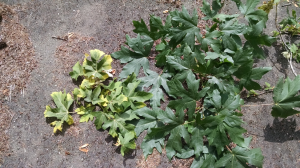This article is an update to those published by the Tree Link in October 2014, “Bigleaf Maple Dieback in Western Washington?” and the follow-up in September of 2015, ” What’s Going on with Bigleaf Maple?“
What’s Going on with Bigleaf Maples (Acer macrophyllum) this year?
DNR’s Forest Health staff continue to receive many calls and emails from concerned residents about the health of bigleaf maples. As in 2015, these contacts started in June and have progressively increased throughout the summer.
The question starts, “what is going on with the bigleaf maples?” followed closely by, “the trees look like they are dying,” or “my tree died.”

Forest pathologists at DNR have been investigating crown, branch and entire tree dieback of bigleaf maples since 2011 and the truth is, we know a lot about what isn’t causing the dieback, but don’t have a good handle on what is causing the dieback. To complicate matters, new leaf symptoms have appeared this year, leaving us with even more head scratching.
This year, we received funding from the federal Animal Plant Health Inspection Service in a cooperative grant between DNR and Washington State Department of Agriculture (WSDA) to process more samples in search of more agents that may be causing the dieback. There continues to be interest in Xylella fastidiosa, a plant pathogen bacterium that colonizes its host plant’s water-conducting system, the xylem, causing water stress in the host. We have tested for this pathogen in the past without any conclusive results but will continue investigating it.

The most common symptoms we have tracked in previous years include crown, branch and entire tree dieback; clumps of shrunken leaves in the affected canopy; and heavy seed crops. This year, we are tracking and sampling from trees that have these symptoms, as well as a new symptom: leaves with yellow edges, red to brown tips and leaf hoppers. Leaves displaying these signs were found in isolated locations in previous years but seem to be widespread this year. These symptoms are similar to bigleaf maple damage observed in California and Oregon and the damage has been attributed to the bacterium Xylella fastidiosa in California. Leaf hoppers can act as a vector for microscopic organisms, like bacterium and viruses, but at this point we are unsure of the species of the leaf hopper or whether it is contributing to the dieback or leaf symptoms we are seeing this year or have seen in years past.

Through our work in previous years with cooperators like Washington State University, Oregon State University, WSDA, US Forest Service, and Oregon Department of Forestry, we have a pretty good idea about what isn’t causing the dieback. For example, we know that:
- There are lots of Pythium ssp. (a common pathogen) out there but the most common are not pathogenic to bigleaf maple in soil tests.
- There is a small amount of pathogenic Phytophthora associated with declining trees, but not enough to be the causal agent across the landscape.
- Armillaria root disease and decay is contributing to some of the tree dieback, but not all of it.
- The wilt disease Verticillium is not widespread and was not found in any of the samples in Washington.
- Stem cankers caused by fungi like Neonectria or Nectria are sometimes present, but not enough to be causing the widespread damage.
- Ganoderma, a causal agent of heartrot, is present in some cases but also is not causing widespread damage, though there are lots of foliar fungi out there that can cause discoloration in leaves.
In addition to our sample collections, Jake Betzen, a University of Washington graduate student, will work on this issue over the next two years. Jake. who was in the field with us during this year’s sampling, will focus his study on: 1) surveying the spatial extent of bigleaf maple dieback and decline (BLMD) and record environmental, anthropogenic, and weather conditions that are associated with BLMD presence and absence; 2) using dendrochronological techniques to analyze and compare growth rates of healthy and symptomatic trees to further differentiate the potential roles of abiotic and biotic drivers of the decline; and 3) determining the spatial-temporal patterns associated with BLMD in western Washington.
Here’s a link to the report from the 2011 survey.
If you have any questions or comments about this project, please contact DNR Natural Resources Scientist Amy Ramsey at: amy.ramsey@dnr.wa.gov.
